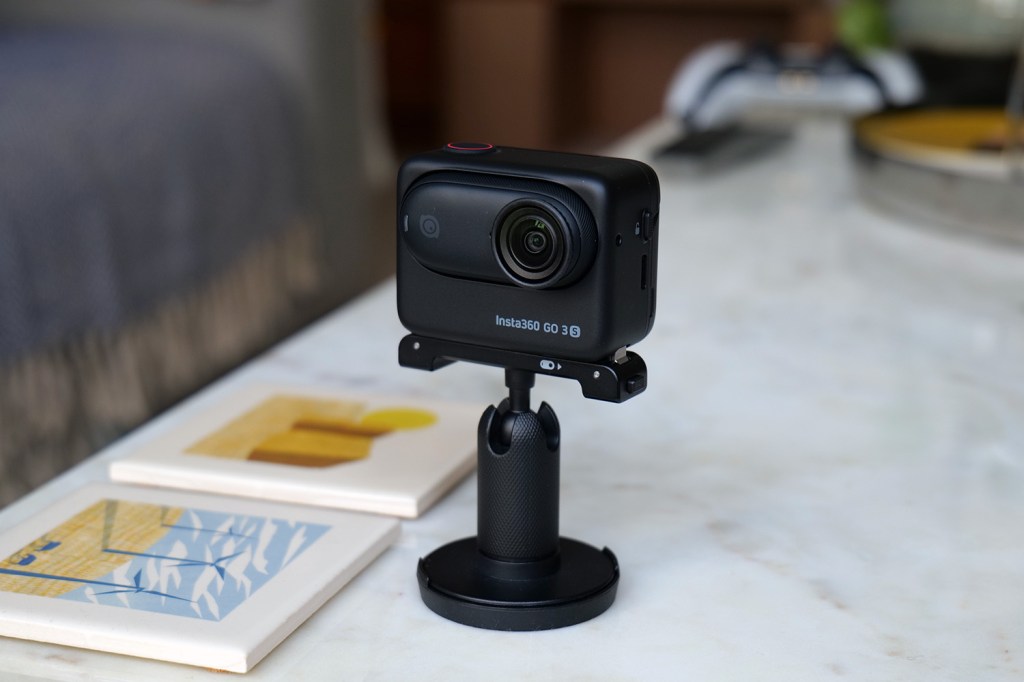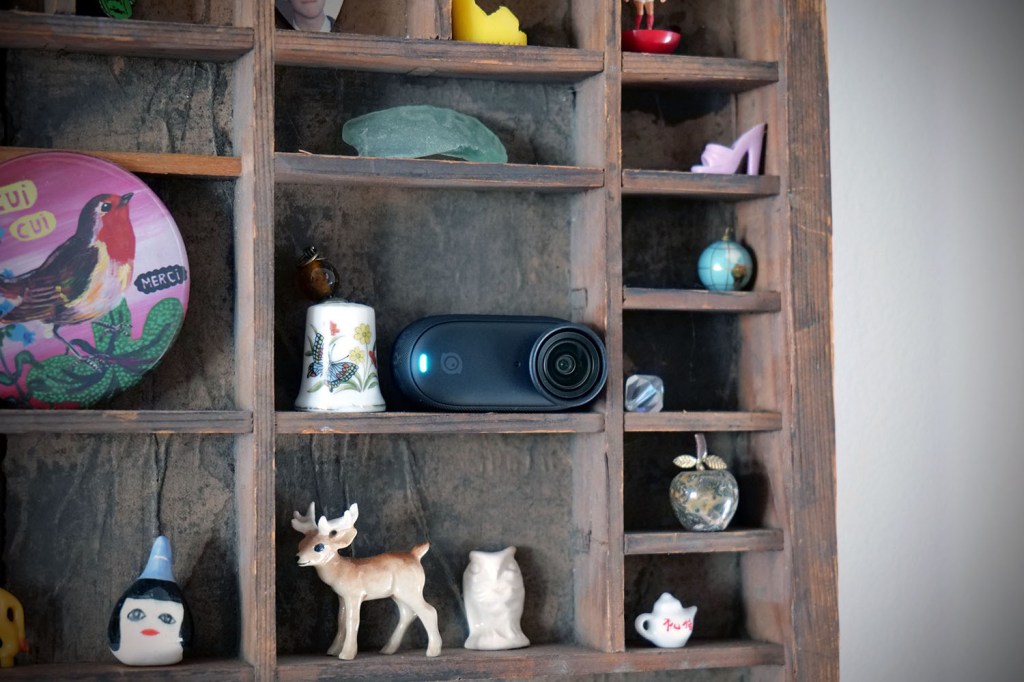Insta360 Go 3S review: small camera, big potential
This boosted Go 3 action cam adds some welcome tweaks

Stuff Verdict
A welcome (if not drastic) improvement over an already appealing camera. The biggest draw – its tiny, lightweight design – remains unchanged for the Insta360 Go 3S.
Pros
- Adds 4K video
- Thumb-sized main camera
- Useful Action Pod charger/remote
Cons
- Worse battery life than Go 3
- FOV not as wide as some action cams
Introduction
I’ve already described 2023’s Insta360 Go 3 as ‘the best little action camera on the planet’ – so what can I say when it gets an updated edition with a sprinkling of improvements?
The Go 3’s big appeal came from its small size, which makes even a GoPro Hero Mini look positively gargantuan. Thankfully, this aspect remains intact in the new Insta360 Go 3S. It’s outwardly identical to the original Go 3, but its upgrades – most notably the much-needed addition of 4K video capture – make it even more alluring. On paper, at least.
Is it worth the upgrade for owners of the Go 3? And do its improvements to image quality move it into GoPro Hero-rivalling territory?
How we test cameras
Every camera reviewed on Stuff is tested in a range of lighting conditions, with a variety of subjects and scenes. We use our years of experience to compare with rivals and assess ergonomics, features and general usability. Manufacturers have no visibility on reviews before they appear online, and we never accept payment to feature products.
Find out more about how we test and rate products.
Design & screen: same little stunner


The Go 3S is exactly the same size as the Go 3, and weighs only about 3g more. That’s the important bit out of the way, because if Insta360 had bulked it noticeably up to achieve that 4K upgrade I’d be very disappointed.
The thumb-like size of the camera unit, and its built-in magnet, means it can be mounted in places other action cameras can’t go. In the course of my review I clipped it to the peak of a baseball cap, attached it to a pendant around my neck, stuck it to fences and even to the frame of my bike – no special mount required. Those of you with more imagination can doubtless think up zanier places for it to go; the creative possibilities its tiny size and minuscule weight open up are endless.
The Action Pod, which acts both as a wireless remote and a dock for the camera unit (adding a 2.2in flip-up touchscreen, more physical controls, a USB-C port and on-the-go recharging) also remains physically unchanged from the Go 3 version. I suppose I’d have liked to see some expandable storage on it (you’re restricted to the built-in storage of either 64GB or 128GB), but maybe I’m just being fussy.
The camera unit gets a slight boost to its waterproofing. It’s now IPX8, and able to be used to a depth of 10m rather than 5m. Users should note, however, that the Action Pod is not fully waterproof, despite its GoPro-esque looks. It’s IPX4, which means it can take a bit of rain or a splash of water, but a full-on dunk is verboten. You can buy a Dive Case accessory to take it beneath the waves.
Interface & battery life: power less


When I reviewed the Insta360 Go 3 last year, I bemoaned the fact that the camera unit only offered 45 minutes of battery life (and that when recording at 1080p/30fps). The Go 3S is even worse in this regard, serving up just 38 minutes. In real-world use it’s even less than that, because you’re probably recording at 4K or 2.7K quality.
You can top up the camera battery fairly quickly by inserting it into the Action Pod, which will top it up like a charging case – but the overall lack of stamina is something to consider when planning a day of shooting. If you include the extra battery life offered by on-the-go charging, it’s about 140 minutes in total.
The interface is unchanged from the Go 3, and I found it to be perfectly usable. On the Action Pod’s touchscreen, you swipe from different edges of the screen to bring up different menus. Even though the screen is small, it’s responsive and I never felt particularly frustrated trying and failing to tap an icon.
As with all Insta360 cameras, there are a lot of shooting modes to choose from, including time-lapse, slow-motion, looping recording, HDR photos and star-lapse. A new mode, Interval Video, automatically records short clips at regular intervals, the idea being to create a video of an entire day trip or similar while conserving battery life.
You can also use the Insta360 mobile app, which takes advantage of your smartphone’s bigger screen to give you a better preview of your shots as well as opening up editing and sharing functionality. I found the app’s editor pretty impressive for quickly knocking together videos, even if the much-vaunted AI editing feature felt a bit lukewarm and often trimmed out the best bits from my clips.
One final new feature worth mentioning: the Go 3S supports Apple Find My, which I think makes a lot of sense given its tiny size and action cam status. If it flies off your bike while you’re riding, you might now have a shot at getting it back.
Photo & video quality: sharper stuff

The new 4K video recording rights a wrong from the original Go 3, delivering a much more detailed and engaging image than the previous 2.7K maximum. It’s limited to 24, 25 or 30fps however, so some users might prefer the smoother (up to 50fps) videos available when the resolution is reduced to 2.7K or 1080p.
The Go 3S also features a different lens to the Go 3. According to the spec sheet this new lens apparently offers a tighter field of view than the old one (16mm equivalent opposed to 11mm equivalent) and a smaller aperture size (f/2.8 opposed to f/2.2), but upon comparing footage captured with both cameras I couldn’t see any real difference in this regard.
I will say that the field of view, as with the Go 3, doesn’t feel as wide as some other action cameras I’ve reviewed. For instance, if you’re used to using one of Insta360’s own 360 cameras, which record everything around them, and a huge arc in front even in single lens mode, the amount of the world that the Go 3S captures can feel a little stingy.
The camera performs at its best outdoors in daylight. Quality falls off quite quickly once the sun goes down or you take it indoors. Noisy grain and smeary artefacts become a lot more noticeable, and that extra detail from the 4K resolution gets a bit lost. It’s hard to avoid given the tiny size of the image sensor I suppose, but my advice would be to reserve the Go 3S for outside use only if you want the cleanest image possible.
Insta360 Go 3S verdict

The Insta360 Go 3S isn’t perfect, and it doesn’t solve the Go 3’s short battery life issue – in fact, its battery life is actually worse. That said, it does bring 4K video into the Go family fold, which is very welcome, and keeps most of what made the Go 3 so attractive intact.
To have a functional action camera this small and versatile is the big draw here, and Insta360 wisely hasn’t changed any of that – it’s just made the best little action camera slightly better.
Insta360 Go 3S technical specifications
| Lens | 16mm f/2.8 |
| Video modes | 4K/30fps, 2.7K/50fps, 1080p/50fps |
| ISO range | 100 to 3200 |
| Stabilisation | FlowState EIS |
| Storage | 64GB / 128GB |
| Connectivity | Bluetooth 5.0, 5GHz Wi-Fi, USB-C |
| Battery life | 38mins / 140mins w/Action Pod (1080p/30fps) |
| Durability | Waterproof to 10m (camera only) |
| Dimensions | 26x54x24.8mm (camera) 39.1g (camera), 96.3g (Action Pod) |


